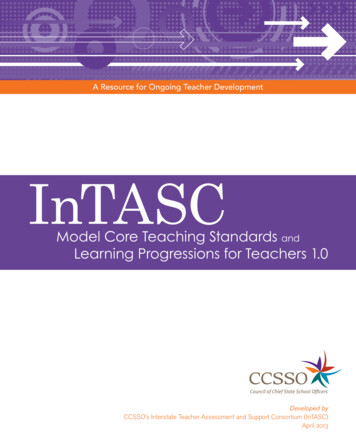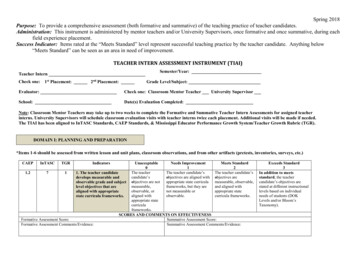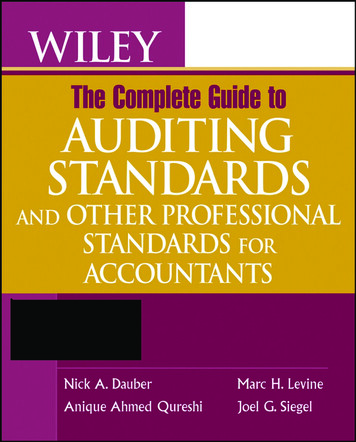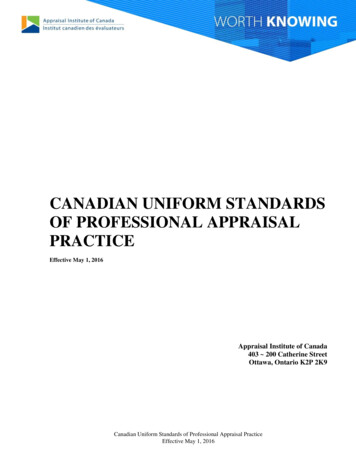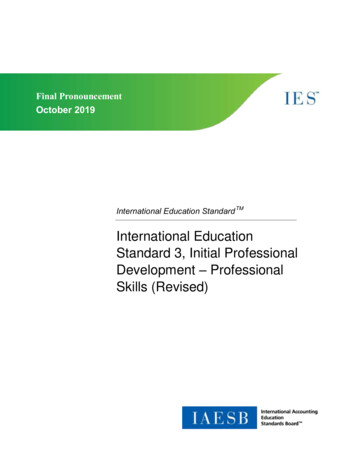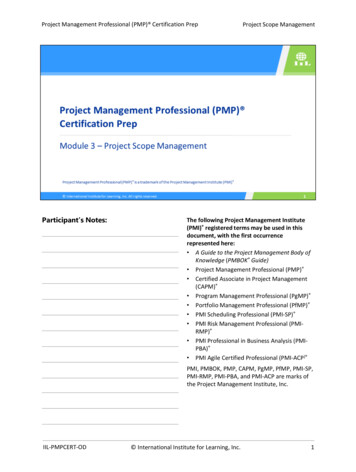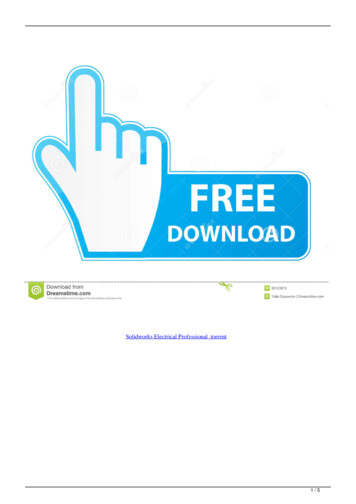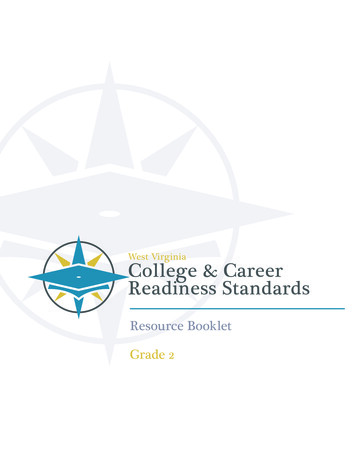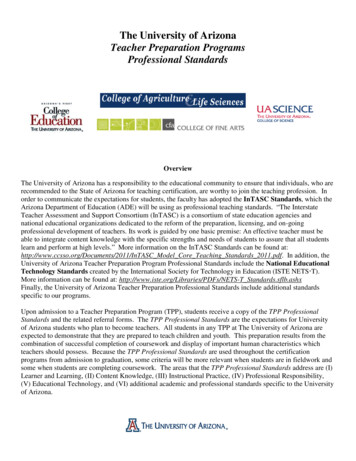
Transcription
The University of ArizonaTeacher Preparation ProgramsProfessional StandardsOverviewThe University of Arizona has a responsibility to the educational community to ensure that individuals, who arerecommended to the State of Arizona for teaching certification, are worthy to join the teaching profession. Inorder to communicate the expectations for students, the faculty has adopted the InTASC Standards, which theArizona Department of Education (ADE) will be using as professional teaching standards. “The InterstateTeacher Assessment and Support Consortium (InTASC) is a consortium of state education agencies andnational educational organizations dedicated to the reform of the preparation, licensing, and on-goingprofessional development of teachers. Its work is guided by one basic premise: An effective teacher must beable to integrate content knowledge with the specific strengths and needs of students to assure that all studentslearn and perform at high levels.” More information on the InTASC Standards can be found at:http://www.ccsso.org/Documents/2011/InTASC Model Core Teaching Standards 2011.pdf. In addition, theUniversity of Arizona Teacher Preparation Program Professional Standards include the National EducationalTechnology Standards created by the International Society for Technology in Education (ISTE NETS T).More information can be found at: http://www.iste.org/Libraries/PDFs/NETS-T Standards.sflb.ashxFinally, the University of Arizona Teacher Preparation Professional Standards include additional standardsspecific to our programs.Upon admission to a Teacher Preparation Program (TPP), students receive a copy of the TPP ProfessionalStandards and the related referral forms. The TPP Professional Standards are the expectations for Universityof Arizona students who plan to become teachers. All students in any TPP at The University of Arizona areexpected to demonstrate that they are prepared to teach children and youth. This preparation results from thecombination of successful completion of coursework and display of important human characteristics whichteachers should possess. Because the TPP Professional Standards are used throughout the certificationprograms from admission to graduation, some criteria will be more relevant when students are in fieldwork andsome when students are completing coursework. The areas that the TPP Professional Standards address are (I)Learner and Learning, (II) Content Knowledge, (III) Instructional Practice, (IV) Professional Responsibility,(V) Educational Technology, and (VI) additional academic and professional standards specific to the Universityof Arizona.
UA students, faculty, staff, and supervisors, as well as cooperating teachers involved with teacher preparationprograms are provided copies of the TPP Professional Standards. As needed or required by each TPP, both UAand field-based professional educators may initiate the form for “Identification of Students ExhibitingOutstanding Performance” and the form for “Identification of Students with Performance Concerns.” Thesereferral forms allow the programs to identify students who display outstanding knowledge, skills, anddispositions that deserve recognition. The procedure is also used to identify students whose performance israising concerns about their ability to successfully complete the program. Students with performance concernsmay be placed on a Professional Growth Plan, with completion of the program dependent on successfuladherence to the plan. Student appeals of this process must follow university policy.
Teacher Preparation Program Professional StandardsI. The Learner and LearningInTASC Standard #1: Learner Development. The teacher understands how learners grow and develop,recognizing that patterns of learning and development vary individually within and across the cognitive,linguistic, social, emotional, and physical areas, and designs and implements developmentallyappropriate and challenging learning experiences.InTASC Standard #2: Learning Differences. The teacher uses understanding of individual differencesand diverse cultures and communities to ensure inclusive learning environments that enable each learnerto meet high standards.InTASC Standard #3: Learning Environments. The teacher works with others to create environmentsthat support individual and collaborative learning, and that encourage positive social interaction, activeengagement in learning, and self motivation.II. ContentInTASC Standard #4: Content Knowledge. The teacher understands the central concepts, tools ofinquiry, and structures of the discipline(s) he or she teaches and creates learning experiences that makethe discipline accessible and meaningful for learners to assure mastery of the content.InTASC Standard #5: Application of Content. The teacher understands how to connect concepts anduse differing perspectives to engage learners in critical thinking, creativity, and collaborative problemsolving related to authentic local and global issues.III. Instructional PracticeInTASC Standard #6: Assessment. The teacher understands and uses multiple methods of assessment toengage learners in their own growth, to monitor learner progress, and to guide the teacher’s and learner’sdecision making.InTASC Standard #7: Planning for Instruction. The teacher plans instruction that supports every studentin meeting rigorous learning goals by drawing upon knowledge of content areas, curriculum, crossdisciplinary skills, and pedagogy, as well as knowledge of learners and the community context.InTASC Standard #8: Instructional Strategies. The teacher understands and uses a variety ofinstructional strategies to encourage learners to develop deep understanding of content areas and theirconnections, and to build skills to apply knowledge in meaningful ways.IV. Professional ResponsibilityInTASC Standard #9: Professional Learning and Ethical Practice. The teacher engages in ongoingprofessional learning and uses evidence to continually evaluate his/her practice, particularly the effectsof his/her choices and actions on others (learners, families, other professionals, and the community), andadapts practice to meet the needs of each learner.InTASC Standard #10: Leadership and Collaboration. The teacher seeks appropriate leadership rolesand opportunities to take responsibility for student learning, to collaborate with learners, families,colleagues, other school professionals, and community members to ensure learner growth, and toadvance the profession.
V. Educational TechnologyNETS T #1: Facilitate and Inspire Student Learning. Teachers use their knowledge of subject matter,teaching and learning, and technology to facilitate experiences that advance student learning, creativity,and innovation in both face-to-face and virtual environments.NETS T #2: Design and Develop Digital Age Learning Experiences and Assessments. Teachers design,develop, and evaluate authentic learning experiences and assessment incorporating contemporary toolsand resources to maximize content learning in context and to develop the knowledge, skills andattitudes identified in the NETS S.NETS T #3: Model Digital Age Work and Learning. Teachers exhibit knowledge, skills and workprocesses representative of a innovative professional in a global and digital society.NETS T #4: Promote and Model Digital Citizenship and Responsibility. Teachers understand local andglobal societal issues and responsibilities in an evolving digital culture and exhibit legal and ethicalbehavior in their professional practices.NETS T #5: Engage in Professional Growth and Leadership. Teachers continuously improve theirprofessional practice, model lifelong learning, and exhibit leadership in their school and professionalcommunity by promoting and demonstrating the effective use of digital tools and resources.VI. University of Arizona Standards for Teacher CandidatesIn addition to the InTASC and ISTE NETS T Standards, teacher candidates at the University of Arizonademonstrate a commitment to their academic program and to education by:attending, being on time, and being prepared for scheduled classes and field experiences;having a professional appearance;communicating professionally and respectfully orally and in writing with peers, colleagues, instructors,K-12 students, teachers, administrators, families, and community members;looking beyond self and respecting differences of race, ethnicity, language, social class, nationalallegiance, cultural heritage, disability or perceived disability, gender, and sexual orientation;accepting and acting upon reasonable criticism;understanding and respecting others’ perspectives;questioning and testing their assumptions about teaching and learning;separating personal and professional issues;exhibiting their knowledge through inquiry, critical analysis, and synthesis of the subject;maintaining or exceeding the minimum grade point average in their respective programs:o CoE - Elementary Education Teacher Preparation Program 2.5 G.P.A. teaching major, 2.5 G.P.A. in general courseworko CoE - Severe and Multiple Disabilities Master’s Program 3.0 G.P.A.o CoE Cross Categorical Special Education Teacher Preparation Program 2.5 G.P.A.o CoE Cross - Categorical Special Education Master’s Program 3.0 G.P.A.o CoE Teach Arizona Master’s Program 3.0 G.P.A.o CoS - Secondary Mathematics Education Program 2.0 G.P.A. in mathematics major, 2.5 G.P.A. in mathematics educationo CoS - Science Teacher Preparation Program 2.5 G.P.A. in science or science education major
o CoA&LS - Agricultural Education Program 2.0 G.P.A.o CoFA - Music Education Program 3.0 GPA in music major, 3.0 overall GPA, successful performance of “Capstone SeniorRecital” on major instrumento CoFA – Art and Visual Culture Education Program 3.0 GPA in art major, 3.0 overall GPA, successful completion of Portfolio ReviewPersons with disabilities, who, with or without reasonable accommodations, are able to complete the essentialrequirements of the program, will not be discriminated against on account of their disabilities. Informationconcerning the accommodation policy can be obtained in the University of Arizona Disability ResourcesCenter.
Finally, the University of Arizona Teacher Preparation Professional Standards include additional standards specific to our programs. Upon admission to a Teacher Preparation Program (TPP), students receive a copy of the TPP Professional Standards and the related referral forms. The TPP Professional Standards are the expectations for University


